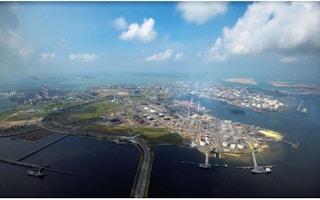Singapore is planning to research and develop carbon capture, use and storage (CCUS) technology to reduce the climate impact of some its most carbon-intensive industries.
To continue reading, subscribe to Eco‑Business.
There's something for everyone. We offer a range of subscription plans.
- Access our stories and receive our Insights Weekly newsletter with the free EB Member plan.
- Unlock unlimited access to our content and archive with EB Circle.
- Publish your content with EB Premium.
A consortium that includes oil giant Chevron, infrastructure consultancy Surbana Jurong, concrete producer Pan-United, and data center operator Keppel Data Centres aims to introduce a range of carbon capture systems for the energy, construction, chemicals and IT sectors within five to 10 years.
The plan is to develop commercially viable systems that can be deployed locally in Singapore, and potentially exported overseas, said the consortium, which is being supported by Singapore’s National Research Foundation (NRF).
Carbon capture technologies are seen as one way to cut the carbon footprint of heavy industry without hurting the economy. High-carbon industries such as oil refining, petrochemicals and specialty chemicals contribute to more than a-fifth of Singapore’s gross domestic product.
“
While Singapore, like the world, is still dependent on fossil fuels for our energy needs, technologies that enable efficient CCUS would help mitigate our emissions greatly.
Low Teck Seng, chief executive officer, National Research Foundation
The technology traps carbon dioxide, which is typically transported and buried it so it does not escape into the atmosphere. In Singapore, the consortium aims to develop mature technologies in combination with new ones that are “cost-efficient, commercial and practical”.
Among them are cryogenic carbon capture, which can reduce emissions from power plants by 95 to 99 per cent at about half of the cost of conventional technologies, and membrane-based carbon capture, whereby carbon dioxide is separated from other exhaust gases via a membrane, and is then collected and stored.
The consortium said that CCUS will help Singapore meet its new climate targets, but did not comment on its potential contribution to meeting those targets. In February, the city-state pledged to hit peak greenhouse gas emissions by 2030, and halve emissions by 2050. Carbon emissions make up 97 per cent of Singapore’s total greenhouse gas emissions.
“While Singapore, like the world, is still dependent on fossil fuels for our energy needs, technologies that enable efficient CCUS would help mitigate our emissions greatly,” said NRF chief executive, Professor Low Teck Seng. CCUS also presents opportunities for converting carbon dioxide into useful materials, he said. Captured carbon dioxide can be used to make soap, fuels, or concrete.
The consortium said the potential cost of the carbon capture systems would depend on the specific technology developed.
The cost and complexity of CCUS technologies have hindered their widespread use to date. One metric tonne of carbon dioxide captured was estimated to cost between US$600 and US$800 with older systems, although new technology has brought the cost down to between US$100 and US$230 per tonne. The cost of individual facilities has run into the billions of dollars.
Peter Godfrey, Asia Pacific managing director of The Energy Institute, an energy industry body, said that the commercial viability of Singapore’s plan was helped by the consortium taking a “clustered approach” that combined a number of industries. He noted that in the United Kingdom, a government-led carbon capture project involved five cluster projects to achieve scale and “reduce costs to commercially viable investment levels.”
CCUS has been a popular decarbonisation method among countries reluctant or unable to quickly transition to different electricity sources, such as solar or wind, and enables the continued burning of fossil fuels with reduced climate impacts. As a petrochemicals-reliant state, Singapore has opted for a slow transition from fossil fuels to clean energy, and its climate targets that have disappointed environmentalists.
Last month, Singapore’s environment minister said the country must take a “pragmatic” approach to climate change, and recognise that the petrochemicals sector will remain a key part of Singapore’s economy, even as the country looks to lower its carbon footprint over the long term. Singapore’s new climate targets of hitting peak emissions by 2030 allow a 58 per cent increase in emissions over 2014 levels.
Singapore’s climate policies were rated as “highly insufficient” by Climate Action Tracker, a research group that tracks international progress on climate action. If all countries had climate policies like Singapore’s, the world would be on course for a catastrophic 3 to 4 degrees Celsius warming by the end of the century, the group projected.
A recent study found that Singapore could be up to 43 per cent powered by solar energy at mid-day by 2050, if the tropical country deployed solar capacity to its maximum potential. However, natural gas remains Singapore’s dominant energy source, accounting for 96 per cent of electricity generation. Gas will continue to play a role in meeting the country’s energy needs for the next 50 years, the country’s trade minister said late last year.










